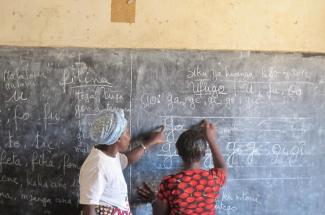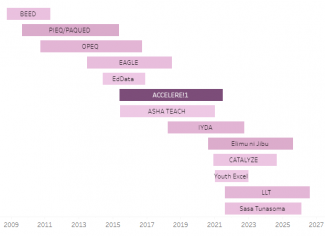The Democratic Republic of Congo (DRC) has made significant strides in increasing school enrollment. Free primary education is becoming a reality, enabling more than 4.5 million children to join school. The policy is not without significant challenges. Right after the policy’s implementation, classrooms were overcrowded, as the number of students increased while the number of teachers tended to decrease. Student–teacher ratios thus became untenable. The main reason was that teachers who were not on the official payroll now lost their main source of income, which was parents’ financial contributions.
Over 4 million children aged 9-14 remain out of school. National and regional data indicate that 67 percent of children who enter first grade will complete sixth grade and only 3.4 percent of ten year olds can read a simple text with comprehension. Significant disparities persist between geographic zones, socioeconomic groups, and genders - with girls’ enrollment dropping off more sharply than boys’ after primary school.
In line with USAID’s objectives under its 2020-2025 Country Development Cooperation Strategy, our education and youth portfolio strengthens education service delivery, access, and quality. Projects work in tandem with the Ministry of Primary, Secondary, and Technical Education, Ministry of Social Affairs, Ministry of Youth, and Ministry of Vocational Training and Trades. USAID/DRC partners with local civil society organizations, the private sector, and both formal and non-formal education centers. Each intervention strives to integrate marginalized populations, including indigenous people, young women and girls, and people with disabilities.
USAID partners with other international organizations through the Global Partnership for Education (GPE) and Education Cannot Wait (ECW) grants in the DRC. Through these networks, we advocate for sector reforms, construct learning spaces, strategically target geographic zones, and develop and distribute textbooks and curricular materials.
USAID also engages with the private sector to expand access to education and improve learning outcomes. Our program targets innovative financing options, mobilizes private sector investment, and incorporates market-based approaches and solutions.
Building on demonstrated effective interventions, our early-grade learning activities provide children aged six to nine years old an opportunity to build solid expressive oral language, reading, and social and emotional skills. These programs support teachers and facilitators to help young learners transition from their home languages into the use of the national and official languages.
In conflict-affected areas of DRC, USAID mitigates the impact of recurrent crises on foundational learning and invests in education services. We carry out effective gender-based violence (GBV) interventions that develop the skills of adolescent girls at risk of sexual assault, early marriage, or child labor.
As the DRC has an extremely youthful population, with over 60 percent under the age of 24, we also prioritize youth development. Our inclusive youth workforce development programming improves access to quality skills training, second-chance education, and adolescent sexual and reproductive health services. These efforts leverage private sector and community engagement to increase sustainable youth work opportunities.

USAID

History of USAID Education Interventions in the DRC. Data from 2009 to 2027. Click on this link to access the interactive tool for more details.
